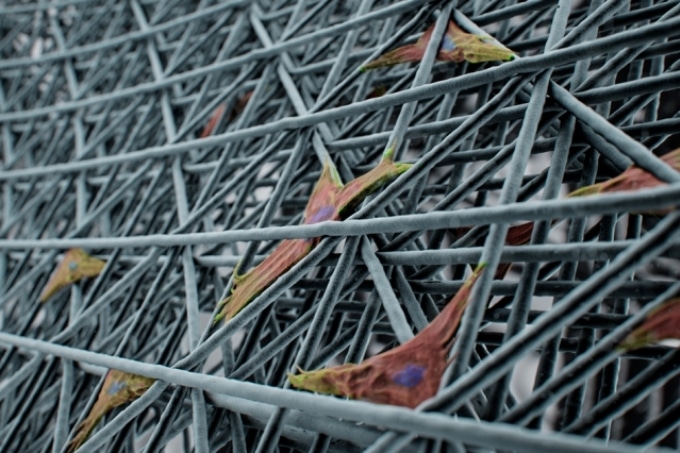Mar 26 2019
An innovative method for creating scaffolding for biological cultures can make it viable to grow cells that are extremely uniform in both size and shape, and possibly have specific functions.
 Microfilaments made using a new 3D printing method, shown in gray in this illustration, form a structure that cells, shown in color, can adhere to. The shapes formed by the filaments determine the very uniform shapes of cells. (Image credit: Eli Gershenfeld)
Microfilaments made using a new 3D printing method, shown in gray in this illustration, form a structure that cells, shown in color, can adhere to. The shapes formed by the filaments determine the very uniform shapes of cells. (Image credit: Eli Gershenfeld)
This latest technique employs a very fine-scale form of 3D printing, utilizing an electric field to draw fibers that have one-tenth the thickness of a human hair.
The novel system was designed by postdoc Filippos Tourlomousis, from MIT’s Center for Bits and Atoms, and six others at the Stevens Institute of Technology in New Jersey and MIT. The results of the study have been recently reported in the journal, Microsystems and Nanoengineering.
There a number of functions in a cell that can be governed by its microenvironment, and therefore, a scaffold that enables accurate control over that environment could pave the way for growing cells with specific traits, for research or ultimately for medical applications.
Normal 3D printing methods are known to create fine filaments that measure 150 µm (that is, millionths of a meter), stated Tourlomousis; however, fibers with a width of 10 µm can possibly be obtained by adding a powerful electric field between the stage on which the structure is getting printed and the nozzle that extrudes the fiber. The method is referred to as melt electrowriting.
“If you take cells and put them on a conventional 3D-printed surface, it’s like a 2D surface to them,” he explained; this is because the cells themselves are relatively smaller. However, when the electrowriting technique was used to print a mesh-like structure, the resultant structure had the same size scale as that of the cells themselves, and hence their shapes and sizes and the way they create adhesions to the material can indeed be controlled. To accomplish this, the porous microarchitecture of the printed lattice structure should be adjusted.
“By being able to print down to that scale, you produce a real 3-D environment for the cells,” stated Tourlomousis.
Tourlomousis along with his team subsequently applied confocal microscopy to view the cells grown in different configurations of fine fibers—some are arbitrary, while some are accurately organized in meshes of varied dimensions. The huge number of images, thus obtained, were then examined and categorized with the help of artificial intelligence techniques, so as to correlate the cell types as well as their inconsistency with the types of the microenvironment, with varied arrangements and spacings of fibers, in which they were cultured.
Cells have the ability to form proteins called focal adhesions at the sites where they fix themselves to the structure.
Focal adhesions are the way the cell communicates with the external environment. These proteins have measurable features across the cell body allowing us to do metrology. We quantify these features and use them to model and classify quite precisely individual cell shapes.
Filippos Tourlomousis, Postdoc, Center for Bits and Atoms, MIT.
For a specified mesh-like structure, he stated that “we show that cells acquire shapes that are directly coupled with the substrate’s architecture and with the melt electrowritten substrates,” inducing a high degree of uniformity in comparison with arbitrarily and nonwoven structured substrates. According to him, uniform cell populations like these may prove useful in biomedical research and he added that “It is widely known that cell shape governs cell function and this work suggests a shape-driven pathway for engineering and quantifying cell responses with great precision,” and with excellent reproducibility.
He further stated that in the latest study, he and his group have demonstrated that specific type of stem cells cultured in such 3D-printed meshes were able to survive without compromising on their characteristics for a much longer period when compared to those cultured on a traditional 2D substrate. Therefore, such structures may prove useful in medical applications, maybe as a means to grow huge amounts of human cells with uniform characteristics that could be utilized for transplantation or to serve as a material for making artificial organs, he added. Polymer melt is the material being utilized for the printing, and this has been already sanctioned by the FDA.
The requirement for more stringent control over cell function is considered to be a significant roadblock for getting products of tissue engineering to the clinic. According to Tourlomousis, any efforts to tighten specifications on the scaffold, and thus also tighten the difference in cell phenotype, are very much required by this sector.
Tourlomousis added that the printing system can also be applied to other applications; for instance, “metamaterials”—artificial materials with patterned or layered structures—can possibly be printed. Such structures can create extraordinary electronic or optical properties.
The research team included Andreas Mershin and Thrasyvoulos Karydis from MIT, and Chao Jia, Dilhan Kalyon, Hongjun Wang, and Robert Chang from the Stevens Institute of Technology in Hoboken, New Jersey. The National Science Foundation funded the study.